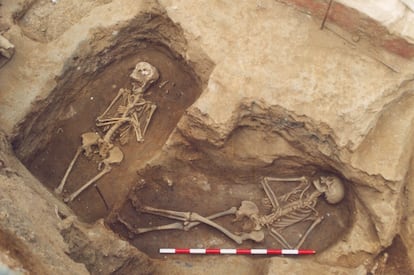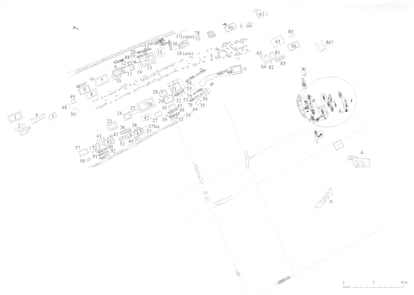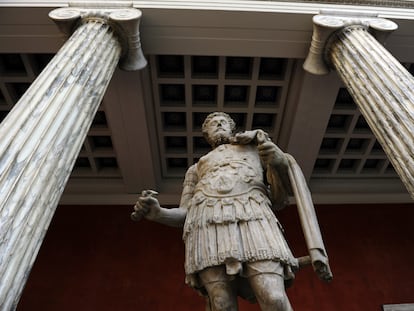A Roman funerary banquet: Pigs for the rich, chicken for the poor… and oats for the women
Animal bones found in a Barcelona necropolis reveal how poorer Romans used cheap meats to reduce the costs of funeral rituals


In the 1950s, a Roman necropolis (or cemetery) was found in the center of Barcelona, hailing from the second and third centuries AD. The site – Plaça de la Vila de Madrid – was excavated again between 2000 and 2003, when a funerary complex of about 500 square feet was discovered. This collective grave – containing the remains or ashes of 66 individuals – was set up to bury slaves or low-income free people.
By paying a monthly fee during their lifetimes, Romans of the lowest echelons could secure decent burials. However, problems arose when relatives had to carry out obligatory ritual banquets in front of the tombs, for not everyone could celebrate the deceased as tradition dictated. For instance, according to authors like Cicero, a tomb was only considered a tomb following the sacrifice of a pig – a high-priced animal beyond the reach of slaves or most citizens.
Within the necropolis, in addition to human remains, some animal bones have also been found, confirming that the funerary rites required by law – such as banquets and offerings – were indeed carried out. A hole was made in the graves, through which food and drink were introduced. Offerings, banquets and animal sacrifices were made to ensure the nourishment and protection of the deities and the memory of the deceased. Archaeologists have also unearthed pottery and plants inside the tombs.
In a study for the academic journal Plos One titled “Food for the soul and food for the body: studying dietary patterns and funerary meals in the Western Roman Empire,” the authors explain that “the age, sex, offerings and diet of the buried individuals show some differences… suggesting that the inequalities present in life could have also persisted in the funerary rituals.”

The human remains found in Vila de Madrid have been subjected to carbon and nitrogen isotope analysis to determine the diet of the buried individuals, so as to contrast it with the remains of the animals consumed during the funerary banquet. And, in addition to human remains, animal bones have also been analyzed. The analysis has determined that 30 percent of identified animals were pigs, 27.1 percent bovines, 24.3 percent goats and 10 percent chickens. Remains of roe deer, hare, rabbit and fox were also documented. The most frequent bones documented were scapulae, humeri, radii, ulnae, pelvis, femurs and tibias, indicating that the parts richest in meat were consumed, although they came from old animals in order to reduce the costs of the banquets.
“This is an important point, as it suggests that only animals that could not be exploited for other purposes were being slaughtered… therefore, the economic burden of slaughtering could be minimized,” notes the article in Plos One.
Women and men in Rome did not eat the same protein sources – men generally ate more meat.
“This could mean that sociocultural tastes for food were different between the sexes, or that more males than females had access to protein-rich resources perhaps due to custom, social status, wealth, or medical advice.” Roman doctors advised “eating different types of food depending on mood.” Men, they thought, were “hot and dry,” so it was recommended that they eat “cold and wet food,” such as fish. Women, on the other hand, were “cold and wet,” so they had to eat “hot and dry food, like oats.”
In short, the study reveals that, “although the offerings and banquets were stipulated by law, not everyone could afford to make sumptuous or rich offerings. The presence of bird remains and portions rich in meat suggest that the relatives of the deceased tried to follow the law as closely as possible.” Yet, it is clear that the poor did not eat like the rich… even in death.
Tu suscripción se está usando en otro dispositivo
¿Quieres añadir otro usuario a tu suscripción?
Si continúas leyendo en este dispositivo, no se podrá leer en el otro.
FlechaTu suscripción se está usando en otro dispositivo y solo puedes acceder a EL PAÍS desde un dispositivo a la vez.
Si quieres compartir tu cuenta, cambia tu suscripción a la modalidad Premium, así podrás añadir otro usuario. Cada uno accederá con su propia cuenta de email, lo que os permitirá personalizar vuestra experiencia en EL PAÍS.
¿Tienes una suscripción de empresa? Accede aquí para contratar más cuentas.
En el caso de no saber quién está usando tu cuenta, te recomendamos cambiar tu contraseña aquí.
Si decides continuar compartiendo tu cuenta, este mensaje se mostrará en tu dispositivo y en el de la otra persona que está usando tu cuenta de forma indefinida, afectando a tu experiencia de lectura. Puedes consultar aquí los términos y condiciones de la suscripción digital.
More information
Últimas noticias
Welcome to the post-religion era: The idea of Christianity as the absolute truth has become obsolete
‘I thought you would like it’: The risky sexual practice popularized by TV shows and TikTok
The digitalization of tourism: ‘They promise experiences and gave us the worst possible one’
Mexican peso defies uncertainty with forecasts of a new period of stability in 2026
Most viewed
- Sinaloa Cartel war is taking its toll on Los Chapitos
- Reinhard Genzel, Nobel laureate in physics: ‘One-minute videos will never give you the truth’
- Oona Chaplin: ‘I told James Cameron that I was living in a treehouse and starting a permaculture project with a friend’
- Why the price of coffee has skyrocketed: from Brazilian plantations to specialty coffee houses
- Silver prices are going crazy: This is what’s fueling the rally










































